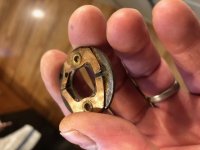Hi John,
I agree that dirt, oil and grime are no friend of any switch. The pitting in the horn contact is caused by the high current and voltage arc when the horn button is depressed. You get an arc when the button is pushed and an arc when it is released due to the inductive load of the horn coil. When we're talking 10-20A of current at 12V, any oil or lubricant is useless since it gets blown away. The horn contact is a scrubbing design and I'm guessing that was done on purpose to push aside any dirt that accumulates. That's why these contacts are not plated- any plating would be scrubbed or blown away by the arc and a waste of money in this application.
In my case where I will be converting the horn circuit and having the horn button energize a 150mA relay coil so there will be no or minimal arcing in the horn button since the horn driving current will be going through a dedicated cadmium/tungsten alloy relay contact designed for this abuse. The task at hand for my application then is to prevent any corrosion products from forming on the bare horn contact material since at these low currents, I will not be blowing the oxides (and base metal) away with an arc. Any corrosion that builds will electrically insulate the contact interface and over time result in a non-functional switch. A light film of a specialty contact lubricant that ideally incorporates deoxidizing compounds (not necessarily grease), is usually enough to prevent these oxides. This is especially important in a vehicles that don't get driven and used daily.
Even the dreaded Lucar connectors can benefit from a spritz of electrical contact lubricant. These are tin plated connectors and are subject to fretting corrosion that leads to the joke about Lucar connectors being in the wire harness to let the smoke out. Fretting corrosion in tin plated electrical contacts results from unlubricated contacts subjected to thermally induced microscopic motions in the contact interface that result from current on-off cycling. As the interface moves ever so slightly during a current carrying/heating cycle, a tin oxide builds on the freshly exposed tin. When the current is switched off, the contact interface microscopically moves back and rides up on these oxides. These cyclically build up over time and increase the interface resistance. In low current applications, that eventually results in an open circuit. In higher current applications, as the interface resistance builds, that in turn heats up the interface as the current goes through it. This increasing temperature eventually builds up to the point where the contact material anneals and you lose contact force in the connector system. Without adequate contact force and these insulating oxides, the result is a nasty thermal cycle that means that the contact burns up or the insulation on the wire going to the connector melts. Lubricating the connector interface of these connectors prevents these oxides from building up and prevents or at least delays this nasty cycle.
In the end, each connector or switch needs to be looked at as to how it will be used (environment, voltage/current, duty cycle, etc) and from that determine what type of contact lubricant, if any, will prevent future problems. Connector & switch technology have come a long way since our 1950's era cars were designed. Contact lubricants can be your friend in these old cars top make them more reliable if properly applied - I speak from background of 35 years of experience in the connector and switch industry.
Ron

 Hey there Guest!
Hey there Guest!
 smilie in place of the real @
smilie in place of the real @
 Pretty Please - add it to our Events forum(s) and add to the calendar! >>
Pretty Please - add it to our Events forum(s) and add to the calendar! >> 

 A friendly reminder - be careful what links you click on here. If a link is posted by someone you don't know, or the URL looks fishy, DON'T CLICK. Spammers sometimes post links that lead to sites that can infect your computer, so be mindful what you click.
A friendly reminder - be careful what links you click on here. If a link is posted by someone you don't know, or the URL looks fishy, DON'T CLICK. Spammers sometimes post links that lead to sites that can infect your computer, so be mindful what you click.